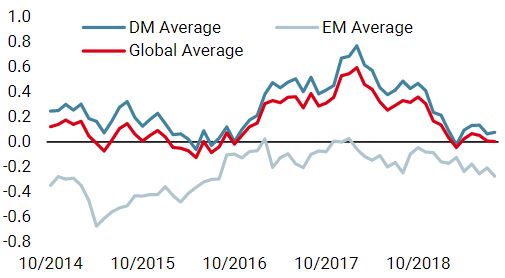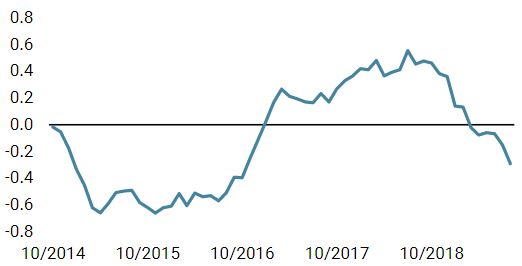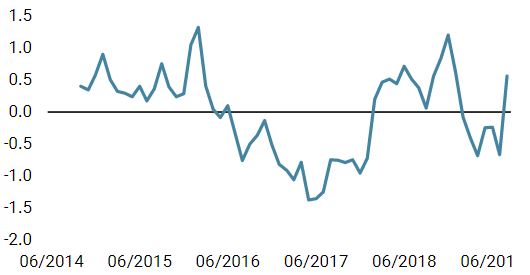August has been a difficult month for risky assets thus far. In total return terms, the MSCI All Country World index is down 4%, with the Emerging Market index down 6%. The Bloomberg Commodity index is down nearly 3% and the Barclays Global High Yield index is down 2%. Hedging assets have provided some cushion, with the Barclays Global Aggregate index up 2%, gold up 7% and the Japanese yen up 3% against a trade-weighted basket, while the Swiss franc rose about 2% against the euro. Investors are clearly concerned about the possibility of an oncoming recession, and with central banks unlikely to announce new policy for a few weeks, sentiment will be in the driver’s seat. Until this dynamic changes and we see central bank policy or macro fundamentals reassert themselves, we will be waiting. For most of this year, investors have largely dismissed a deteriorating macro picture, taking comfort in the dovish pivot by most central banks. Bad news was good news since it made the case clearer for more accommodative monetary policy. The month of August however has seen some of this sky-high faith in the ability of central banks to reverse a downturn come down to earth. A plethora of evidence points to investor sentiment turning more sceptical on the prospects for global growth: As we have previously communicated, global growth has been steadily declining since early 2018. For the last few months, we have seen a stabilisation around potential levels, but with important divergences: The developed world has seen a small bounce (driven mostly by the US), while the emerging world has seen a modest decline (due mostly to China). Typically, the economy does not stay at potential levels for long, especially after a strong deterioration, as pressure to support the expansion leads to fiscal and/or monetary stimulus or the downward trend is too strong and recession follows.“I’ll Be Waiting” – Adele, 2011
What’s Next?
Is bad news finally bad news?
What are the prospects for global growth?
Today, there is a clear tension between the US economy and the rest of the world, and the future path of the global economy depends on how this tension is resolved. Our proprietary Nowcasters, which incorporate hundreds of data series across the various facets of the economy, point to growth in the US being rather healthy. Although the US economy is not expanding as quickly as it was a year ago, it still looks to be growing above potential levels, supported by investment, employment, and consumption. Financing conditions do not appear restrictive, despite the rise of the Fed funds target rate. Thus, in our view, the likelihood of an imminent recession in the US remains rather low, despite the inversion of the yield curve.
The Eurozone is at much greater risk, however. We have highlighted for some time that the region has been close to recessionary levels, according to our Nowcaster, dragged down by employment, consumption, and production. Given the Eurozone’s strong link to global growth via external trade, the broader global growth slowdown, as well as trade uncertainty, has hit these economies hard. Importantly, financing conditions are not a drag and, in our view, the supply of credit in the region is not an issue. This is one of the reasons we are sceptical that a lower deposit rate, refinancing operations, or quantitative easing will be sufficient to shake the Eurozone’s real economy out of its malaise (though the impact on its financial markets would be quite positive).
The Chinese economy also appears to be at risk, in our view. It has been hit by both weaker housing and external demand, the latter a natural consequence of global trade uncertainty. While policymakers have many tools at their disposal to stimulate domestic demand, they have little control over the uncertainty emanating from the White House, as the past week (and year) has shown. Indeed, we have seen a strong deterioration in our Chinese Growth Nowcaster over the last few months, which fell from around potential to levels indicative of a significant slowdown at end of last month. On a positive note, consumption, production, and financing conditions are still decent.

The central macro question is whether easier Fed policy and a resilient US economy will be able to pull up the global economy or whether trade uncertainty and weak rest-of-world demand will drag the US down with the others into recession. It is difficult to say which of these is likely to transpire, and with a host of central bank meetings behind us, the ebb and flow of investor sentiment will drive markets. Valuations have retraced somewhat, but there are few obvious opportunities and hedging assets remain expensive. While we think central banks will continue responding to the economic slowdown with more accommodation, thereby buoying markets, we have become more cautious in our exposures. Markets will likely focus on sentiment, which remains challenging for many assets. In particular, we are largely neutral on equity markets, underweight credit, and slightly overweight sovereign bonds. We also continue to implement option strategies that will benefit from a large equity correction. Until we perceive that the market is ready to shift its focus from rather negative sentiment to a central bank-backed positive macro momentum, we think it is best to remain cautious.Where do we go from here?

I’ll Be Waiting

Our medium-term views remain cautious, and we prefer to get exposure to growth via high yield corporate credit. We are also complementing our modest equity exposure with options to protect the portfolio in the case of equity drawdowns. Over the month of August, the Multi Asset Risk Targeted Strategy is down 0.4% while the MSCI AC World Index lost 3.8% and the Barclays Global Aggregate (USD hedged) is up 1.9%. Year-to-date, the Multi Asset Risk Targeted Strategy has returned 7.9% versus 12.1% for the MSCI AC World index, while the Barclays Global Aggregate (USD hedged) index is up 8.9%. * The Multi Asset Risk Targeted Strategy performance is shown in USD net of fees for the representative account of the Multi Asset Risk Targeted (Medium) USD Composite and reflects the deduction of advisory fees and brokerage commission and the reinvestment of all dividends and earnings. Past performance is not indicative of future performance. This information is presented as supplemental information only and complements the GIPS compliant presentation provided on the following page.Strategy Behaviour
Performance Review
Unigestion Nowcasting
World Growth Nowcaster

World Inflation Nowcaster

Market Stress Nowcaster

Weekly Change
- Our world Growth Nowcaster dropped marginally over the past week, driven by lower growth conditions in both developed and emerging markets.
- Our world Inflation Nowcaster decreased sharply this week once again, mainly driven by the lower inflation prospects in the US.
- Market stress remained unchanged at very high levels.
Sources: Unigestion. Bloomberg, as of 19 August 2019.
Important Information
Past performance is no guide to the future, the value of investments can fall as well as rise, there is no guarantee that your initial investment will be returned. This document has been prepared for your information only and must not be distributed, published, reproduced or disclosed by recipients to any other person. This is a promotional statement of our investment philosophy and services only in relation to the subject matter of this presentation. It constitutes neither investment advice nor recommendation. This document represents no offer, solicitation or suggestion of suitability to subscribe in the investment vehicles it refers to. Please contact your professional adviser/consultant before making an investment decision. Where possible we aim to disclose the material risks pertinent to this document, and as such these should be noted on the individual document pages. Please contact Unigestion for a complete list of all the applicable risks. Some of the investment strategies described or alluded to herein may be construed as high risk and not readily realisable investments, which may experience substantial and sudden losses including total loss of investment. These are not suitable for all types of investors. To the extent that this report contains statements about the future, such statements are forward-looking and subject to a number of risks and uncertainties, including, but not limited to, the impact of competitive products, market acceptance risks and other risks. As such, forward looking statements should not be relied upon for future returns. Data and graphical information herein are for information only and may have been derived from third party sources. Unigestion takes reasonable steps to verify, but does not guarantee, the accuracy and completeness of this information. As a result, no representation or warranty, expressed or implied, is or will be made by Unigestion in this respect and no responsibility or liability is or will be accepted. All information provided here is subject to change without notice. It should only be considered current as of the date of publication without regard to the date on which you may access the information. Rates of exchange may cause the value of investments to go up or down. An investment with Unigestion, like all investments, contains risks, including total loss for the investor.
This information is issued by Unigestion (UK) Ltd (“Unigestion”), which is authorised and regulated by the UK Financial Conduct Authority (“FCA”). Unigestion is also registered as an investment adviser with the U.S. Securities and Exchange Commission (“SEC”). This information is intended only for professional clients, institutional clients and eligible counterparties, as defined by the FCA, and qualified purchasers as defined by the SEC and has therefore not been adapted to retail clients.
Unigestion Multi Asset Risk-Targeted (USD): 31 December 2014 to 30 June 2019
| Year | Composite Return Gross of Fees |
Composite Net Return | Benchmark Return | Number of Accounts | Internal Dispersion | Composite 3-Yr Std Dev | Benchmark 3-Yr Std Dev | Composite AUM (M) | Firm AUM (M) |
| 2015 | -1.61% | -2.80% | – | 1 | – | – | – | 127.24 | 15,550.31 |
| 2016 | 5.05% | 3.79% | – | 1 | – | – | – | 129.66 | 18,144.46 |
| 2017 | 11.16% | 9.82% | – | 1 | – | – | – | 169.51 | 22,340.80 |
| 2018 | -2.91% | -4.08% | – | 1 | – | – | – | 286.93 | 21,403.49 |
| 20191 | 7.45% | 6.80% | – | 1 | – | – | – | 364.46 | 21,692.55 |
1: This year is incomplete, it stops in June.
Special Disclosure: For presentations prior to 31.03.2018 the strategy was measured against the LIBOR 3M USD + 4%. Beginning April 2018 the firm determined that the benchmark did not accurately reflect the strategy mandate and the benchmark was removed. Definition of the Firm: For the purposes of applying the GIPS Standards, the firm is defined as Unigestion. Unigestion is responsible for managing assets on the behalf of institutional investors. Unigestion invests in several strategies for institutional clients: Equities, Hedge Funds, Private Assets and the solutions designed for the clients of our Cross Asset Solution department. The GIPS firm definition excludes the Fixed Income Strategy Funds, which started in January 2001 and closed in April 2008, and the accounts managed for private clients. Unigestion defines the private clients as High Net Worth Families and Individual investors. Policies: Unigestion policies for valuing portfolios, calculating performance, and preparing compliant presentations are available upon request. Composite Description: The Multi Risk Targeted (Medium) composite was defined on 15 December 2014. It consists of accounts which aim to deliver consistent smooth returns of cash + 5% gross of fees across all market conditions over a 3-year rolling period. It seeks to achieve this by capturing the upside during bull markets while protecting capital during market downturns. Benchmark: Because the composites strategy is absolute return and investments are permitted in all asset classes, no benchmark can reflect this strategy accurately. Fees: Returns are presented gross of management fees, administrative fees but net of all trading costs and withholding taxes. The maximum management fee schedule is 1.2% per annum. Net returns are net of model fees and are derived by deducting the highest applicable fee rate in effect for the respective time period from the gross returns each month. List of Composites: A list of all composite descriptions is available upon request. Minimum Account Size: The minimum account size for this composite is 5’000’000.- USD. Valuation: Valuations are computed in US dollars (USD). Performance results are reported in US dollars (USD). Internal Dispersion & 3YR Standard Deviation: The annual composite dispersion presented is an asset-weighted standard deviation calculated for the accounts in the composite the entire year. When internal dispersion is not presented it is as a result of an insufficient number of portfolios in the composite for the entire year. When the 3 Year Standard Deviation is not presented it is as a result of an insufficient period of time. Compliance Statement Unigestion claims compliance with the Global Investment Performance Standards(GIPS®) and has prepared and presented this report in compliance with the GIPS standards. Unigestion has been independently verified for the periods 1 January 2003 to 31 December 2016. The verification report(s) is/are available upon request. Verification assesses whether (1) the firm has complied with all the composite construction requirements of the GIPS standards on a firm-wide basis and(2) the firms policies and procedures are designed to calculate and present performance in compliance with the GIPS standards. Verification does not ensure the accuracy of any specific composite presentation.
